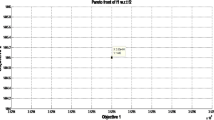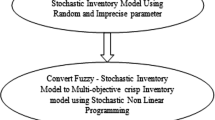Abstract
In real-life problems, there is always a situation where a decision maker is engrossed in detecting multi aspiration levels for the purposes that cannot be explained in specific way. To address this, the paper aims to consider a new generalized non-linear intuitionistic fuzzy number and, hence, defined the possibilistic mean of it with possibility measures. In addition, we have proposed the arithmetic operations of different generalized non-linear intuitionistic fuzzy number using \((\alpha , \beta )\)-cut method. The applicability of the developed operations are explained with a case study from the multi-item inventory model in which the price and quality dependent demand are modeled under the generalized non-linear intuitionistic fuzzy environment. A new defuzzification method has been developed to solve the developed multi-item inventory model. Finally, numerical and graphical representation of the proposed model has been discussed to highlight the superiority of the presented work.






Similar content being viewed by others
References
Abou-el-ata MO, Kotb KMA (1997) Multi-item EOQ inventory model with varying holding cost under two restrictions: a geometric programming approach. Prod Plan Control 8:608–611
Atanassov KT (1986) Intuitionistic fuzzy sets. Fuzzy Sets Syst 20:87–96
Atanassov KT, Gargov G (1996) Interval valued intuitionistic fuzzy set. Fuzzy Sets Syst 79:403–405
Ban A (2008) Trapezoidal approximations of intuitionistic fuzzy numbers expressed by value, ambiguity, width and weighted expected value. Twelfth International Conference on IFSs, Sofia 14(1):38–47
Carlsson C, Fuller R (2001) On possibilistic mean value and variance of fuzzy numbers. Fuzzy Sets Syst 122:315–326
Chakraborty D, Jana DK, Roy TK (2014) A new approach to solve intuitionistic fuzzy optimization problem using possibility, necessity and credibility measures. Int J Eng Math 20:1–20
Chakraborty D, Jana DK, Roy TK (2016) Expected value of intuitionistic fuzzy number and its application to solve multi-objective multi-item solid transportation problem for damageable items in intuitionistic fuzzy environment. J Intell Fuzzy Syst 30:1109–1122
Dubois D, Prade H (1988) Possibility theory: an approach to computerized processing of uncertainty. Plenum, New York
Fuller R, Majlender P (2003) On weighted possibilistic mean and variance of fuzzy numbers. Fuzzy Sets Syst 136:363–374
Garai T, Chakraborty D, Roy TK (2018) A multi-item generalized intuitionistic fuzzy inventory model with inventory level dependent demand using possibility mean, variance and covariance. J Intell Fuzzy Syst 35:1021–1036
Garg H (2014) Inventory models involving variable lead time, backorder discounts and lost sales using. World Conference on Soft Computing in Industrial Application 1:1–12
Garg H (2015) Fuzzy inventory models for deteriorating items using different types of lead-time distributions. Intell Tech Eng Manag 87:247–274
Garg H, Rani M, Sharma SP, Vishwakarma Y (2014) Intuitionistic fuzzy optimization technique for solving multi-objective reliability optimization problems in interval environment. Expert Syst Appl 41:3157–3167
Gupta R, Vrat P (1986) Inventory model with multi-items under constraint systems for stock dependent consumption rate. Oper Res 24:41–42
Hariri AMA, Abou-el-ata MO (1997) Multi-item production lot size inventory model with varying order cost under a restriction: a geometric programming approach. Prod Plan Control 8(6):179–182
Klir JK (1999) On fuzzy set interpretation of possibility. Fuzzy Sets Syst 108:263–273
Kumar M, Ganesh UR (2018) Multi-item inventory model with variable backorder and price discount under trade credit policy in stochastic demand. Int J Prod Res 57:298–320
Lee YP, Dye CY (2012) An inventory model for deteriorating items under stock-dependent demand and controllable deterioration rate. Eur J Oper Res 63:474–482
Li C, Jin J (2018) A scalar expected Value of intuitionistic fuzzy random individuals and its application to risk evaluation in insurance companies. Math Probl Eng 18:1–16
Liu F, Yuan XH (2007) Fuzzy number intuitionistic fuzzy set. Fuzzy Syst Math 21:88–91
Mahapatra GS, Roy TK (2013) Intuitionistic fuzzy number and its arithmetic operation with application on system failure. J Uncertain Syst 7(2):92–107
Mandal NK, Roy TK, Maiti M (2006) Inventory model of deteriorated items with a constraint: a geometric programming approach. Eur J Oper Res 173(1):199–210
Nayagam VLG, Jeevaraj S, Sivaraman G (2016) Complete ranking of intuitionistic fuzzy numbers. Fuzzy Inf Eng 8:237–254
Prakash KA, Suresh M, Vengataasalam S (2013) A new approach for ranking of intuitionistic fuzzy numbers using a centroid concept. Math Sci 10:177–184
Rani D, Gulati TR, Garg H (2016) Multi-objective non-linear programming problem in intuitionistic fuzzy environment: optimistic and pessimistic view point. Experts Syst Appl 64:228–238
Roy TK, Maiti M (1998) Multi objective models of deteriorating items with some constraints in a fuzzy environment. Comput Oper Res 25(12):1085–1095
Singh T, Mishra PJ, Pattanayek H (2018) An EOQ inventory model for deteriorating items with time dependent deterioration rate, ramp-type demand rate and shortages. Int J Math Oper Res 12(4):423–437
Waliv RH, Umap HP (2018) Multi-item two ware-house fuzzy inventory model. Int J Procure Manag 11(4):443–454
Wan PS (2013) Multi-attribute decision making method based on possibility variance coefficient of triangular intuitionistic fuzzy numbers. Int J Uncertainty Fuzziness Knowl Based Syst 21:223–243
Wan PS, Dong YJ (2015) Possibility method for triangular intuitionistic fuzzy multi-attribute group decision making with incomplete weight information. Int J Comput Intell Syst 7:65–79
Wan PS, Li FD, Rui FZ (2013) Possibility mean, variance and covariance of triangular intuitionistic fuzzy numbers. J Intell Fuzzy Syst 24:847–858
Wu J, Liu JY (2013) An approach for multiple attribute group decision making problems with interval-valued intuitionistic trapezoidal fuzzy numbers. Comput Ind Eng 66:311–324
Wu KS, Ouyang LY, Yang CT (2006) An optimal replenishment policy for non instantaneous deteriorating items with stock-dependent demand and partial backlogging. Int J Prod Econ 101:369–384
Xue F, Tang W, Zhao R (2008) The expected value of a function of a fuzzy variable with a continuous membership function. Comput Math Appl 55:1215–1224
Yager RR (1992) On the specificity of a possibility distribution. Fuzzy Sets Syst 50:279–292
Zadeh AL (1965) Fuzzy sets. Inf Control 8:338–356
Zadeh AL (1978) Fuzzy sets as a basis for a theory of possibility. Fuzzy Sets Syst 1:3–28
Zhang QL, Liu F, Fan CQ, Xie WH (2018) Fuzzy numbers and intuitionistic fuzzy descriptor systems. Inf Sci 469:44–59
Author information
Authors and Affiliations
Corresponding author
Additional information
Communicated by Marcos Eduardo Valle.
Publisher's Note
Springer Nature remains neutral with regard to jurisdictional claims in published maps and institutional affiliations.
Rights and permissions
About this article
Cite this article
Giri, S.K., Garai, T., Garg, H. et al. Possibilistic mean of generalized non-linear intuitionistic fuzzy number to solve a price and quality dependent demand multi-item inventory model. Comp. Appl. Math. 40, 110 (2021). https://doi.org/10.1007/s40314-021-01497-4
Received:
Revised:
Accepted:
Published:
DOI: https://doi.org/10.1007/s40314-021-01497-4
Keywords
- Generalized non-linear intuitionistic fuzzy number
- Possibilistic mean
- Multi-item inventory
- Price- and Quality-dependent demand




